Common Problems
Common Surveying Problems

Asbestos
Asbestos is a generic term used in reference to fibrous forms of mineral silicates which naturally occur in igneous and metamorphic rocks. Asbestos has desirable qualities such as incombustibility and its strength when combined with other materials (such as plastic or cement) lends itself to be an effective reinforcement agent. As a result, asbestos fibres have been exploited commercially and can be found in many building materials. In the UK only two forms are known to have been used significantly:
- Chrysolite (white asbestos).
- Crocidolite (blue asbestos).
It is widely recognised that the inhalation of airborne fibres of asbestos can cause significant health problems, although this was not recognised until 1920. Due to increasing concerns of its health and safety risks, the use of asbestos fibres was banned in the UK in 1999
Commonly recognised uses for asbestos in the home are:
- Asbestos cement roof tiles.
- Corrugated asbestos cement sheet roof claddings.
- Asbestos cement pipework (commonly soil and vent pipes).
- Asbestos cement sheet claddings (walls and soffits etc.).
- Insulation board ceiling finishes.
- Artex (or similar textured) ceiling finishes.
- Certain composite floor tiles (e.g. thermoplastic).
- Vermiculite insulation.
There are various methods for eradication and management which may be advised by appropriate experienced contractors. It should be ensured that any remediation works are certificated on completion and a suitable transferrable guarantee of its eradication is issued.
Where it is suspected that building materials containing asbestos fibres are present no works which would disturb these components should be undertaken before consulting an appropriate expert. If asbestos is found to be present the removal or disposal of materials affected will be increased.

Buttress
A buttress is a form of architectural structure constructed against a building which has suffered from structural movement. The buttress will serve as a counteracting reinforcement, supporting the wall and preventing the movement becoming progressive.
Buttresses are not uncommon, especially in older structures. Their presence immediately suggests that some form of structural movement has occurred in the past as they are not a feature which would be contemporary with the original structure. Therefore, a surveyor may call for a structural engineer’s opinion to ensure progressive movement is not a cause for concern.
If a property includes a buttress, or buttresses, this should be declared to your buildings insurance company.
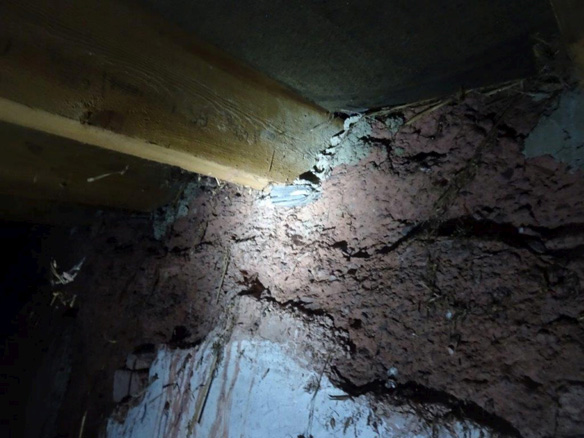
Cob
A very old form of construction being a variable combination of clay, lime, horsehair, straw, small pebbles, etc., laid in position in much the same way that shuttered concrete is today. Usually cob walls are found in conjunction with traditional stone walls.
Cob is fairly durable but if maltreated is highly unpredictable. The material is very much like a soft clay riverbank and needs protection in order to prevent erosion occurring. A lime render or slurry should be used. Sand cement render has been used over the last five or six decades and this can cause problems by trapping moisture within the wall. Slight moisture may be required in order for the material to retain its characteristics as a lump rather than turning to dust or soft mud.
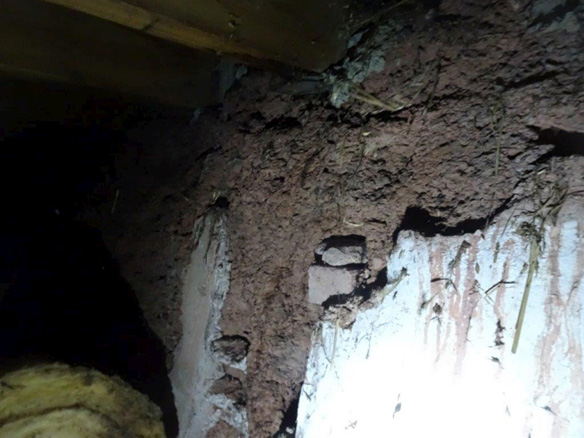
Cob
Cob is occasionally prone to very sudden failure normally caused by moisture being trapped at the base of a wall allowing the cob to turn into mud thus permitting the wall to slide rapidly out of position (usually into the garden or road).
While there are some risks attached to this type of construction given sensible maintenance the incidence of failure reduces dramatically. This construction is generally acceptable in the market place but may attract a higher premium rating from insurers. The return to lime based products means that cob is now being used again. Cob blocks for repair purposes are available locally.
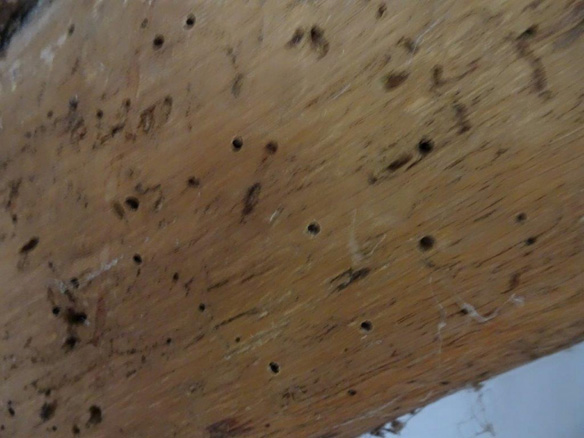
Death Watch Beetle
Deathwatch beetles damage property by boring tunnels in dead hardwood timbers, often found in historic buildings. Their larvae live in the wood for years, causing structural weakening that can compromise buildings. The presence of an infestation is signaled by the tapping sounds adults make to attract mates and by exit holes (about 4mm in diameter) in the wood surface. Proper treatment involves reducing moisture, removing infested wood, and consulting a professional surveyor to prevent significant structural damage, especially in older properties.

Condensation
Condensation is a problem that occasionally causes considerable damage within buildings. Condensation is occurring frequently nowadays as homes are much more draught free. Modern bathrooms/showers, kitchen facilities and the use of heating all creates vapour, etc. which increases the humidity within buildings. Condensation occurs principally during the winter months on the coldest areas of the structure. This creates beads of moisture on windows and walls causing unsightly mould growths (which as most vendors have prior knowledge of our inspection are easily washed off). Sensible heating/ventilation can control the problem. Domestic dehumidifiers are also now available but should not be essential.
Occasionally condensation occurs in the roof space causing rot and leading to structural failure of the roof carcassing. Efficient ventilation of such closed areas needs to be provided as buildings are insulated and upgraded.
Today's Building Regulations require that mechanical ventilation routed externally (not to the loft) is provided to all kitchens and bathrooms to new buildings or conversions, along with trickle ventilators to windows, etc. Additional mechanical ventilation can be prudent to cloakrooms or utilities etc. where condensation can be an issue. It is sensible to provide these to older buildings. Good ventilation may also help reduce Radon Gas levels.
Where condensation problems persist the installation of a positive pressure unit is a potential solution. These comprise a ventilation system whereby fresh air is drawn in then gently and continuously introduced throughout the property, diluting the stale/moist air which causes condensation staining.
Excessive moisture as caused by prolonged condensation, severe dampness, burst pipes and flooding have recently been associated with the later development of toxic moulds causing severe health problems to occupiers. This can be expensive to detect and eliminate.

Damp
Water is the single largest cause of deterioration to buildings. It is essential that moisture entry be prevented or eliminated from areas intended to be dry.
The southwest is an area subject to considerable driving rainfall so penetrating damp can be a major problem, especially in those more exposed coastal locations.
In a modern structure the cavity, together with associated trays and damp proof courses, should prevent the transfer of moisture to the interior. Where damp issues are evident in a structure of this type it could be as a result of debris build up in the cavity or omissions from the original construction, further investigation might be necessary.
In solid walls the level of exposure, wall thickness, construction type and external finishes determine whether penetrating damp may now or in the past have existed causing damage to timbers that are frequently concealed (e.g. floor joist ends, lintels) and to plaster etc. When purchasing a property of traditional solid stone construction a certain amount of damp presence is expected due to the nature of the build. Subsequent works of damp proofing such as tanking could be implemented to reduce excessive dampness.
Keeping rainwater goods, windows, sills, render and pointing etc. in good condition will prevent or minimise damp penetration. Where problems persist spraying walls externally with a silicone water repellent every few years can help but it will not overcome poor finishes since it cannot bridge fine cracks. In severe circumstances external cladding, render with a moisture inhibitor or tanking material incorporated etc. may be the only solution.
This picture is an example of dampness occurring due to water ingress via the chimney.
This is the most severe fungal problem but it is fairly rare. Dry rot usually occurs where timbers are adjacent to a source of slight dampness combined with a poorly ventilated “warm” environment. When it is developing it is usually concealed in voids or behind plaster, etc., and thus very difficult or impossible to detect. Only when it is well established or under distress does it rapidly produce the large fruiting bodies and spores which (normally being on an exposed surface) are easily recognised. Items including joist ends, lintels, panelling, timber walls, skirtings and window/door frames are at risk.
Concealed timbers are at the greatest risk. The dry rot fungus is capable of transporting moisture to digest otherwise dry timber even growing through masonry. On opening up outbreaks are normally found to be far more extensive than one might have expected. Given the correct conditions the dry rot fungus can grow very rapidly, up to 20' (6.5m) per annum in any direction. In “cold” conditions it tends to ‘hibernate’.
It is impossible to give a total assurance that dry rot is not present as the superficially visible evidence is usually only present once the outbreak is well established. Many older buildings offer the correct conditions for the development of dry rot (or the reactivation of a concealed "dormant" infestation) but the incidence is rare, where it does occur it is often devastating and very expensive to eliminate. Small changes in the status quo of a building (e.g. by alterations to the pattern of heating and ventilation) can be sufficient to create the conditions where dry rot quickly develops.
Avoidance of wet and dry rot internally is possible by eliminating all moisture. In some historic buildings this may not be desirable (see Dampness above) and some risk may have to be tolerated. If dry rot is suspected it demands urgent attention by an expert. Where dry rot has been treated previously there seems to be a likelihood that it will reoccur.

Flooding
Many properties across the South West could be prone to damages caused by flooding, especially those in prime coastal locations. If a property is identified as being in a flood risk area by rivers or seas insurance may not be obtainable on normal terms. Thus, mortgageability, saleability and value may be affected. A property could also be prone to flooding by rising water tables or poor surface water drainage.
A simple search can be undertaken on the Environment Agency website to check whether your property lies in a flood risk area, just follow this link!

Flat Roofing
Flat felt roofs are cheaper alternative to pitched roofs but have a limited life, typically about 10 - 15 years although some of the newer felts are thought to be capable of lasting longer.
The type of decking (usually concealed) can influence the life greatly, as can the location of the property and its exposure etc. Often the decking needs to be renewed as well as the covering.
Asphalt flat roofs typically have a life of up to 30 years, again, dependent on the decking, exposure, etc.
Polymer single ply roofing systems are a reasonably modern alternative to traditional flat roof coverings, comprising a single sheet of material (of which there are over seven generic types currently used in the UK) to provide increased versatility and a clean/smooth finish. If properly installed life expectancy can be in excess of 25 years, although if fitted incorrectly the covering can be prone to ‘puncturing’.
Fibreglass claddings are occasionally used for flat roofs but there are few approved contractors locally. Such claddings are currently viewed with suspicion but should have a life of 10 – 15 years or more.
Repair and replacement of flat roofs needs to be done by a specialist contractor offering a worthwhile warranty.
The provision of insulation and ventilation (to avoid condensation problems) should be undertaken when recovering the roof. Sometimes insulation can be provided above the decking to create a "warm deck" roof which will not require ventilating.

Flying Freehold
A flying freehold occurs where part of a property extends over a neighbouring property, or vice versa (excluding flats). Flying freeholds are not particularly common and are often involving small sections of the accommodation. However, where a property is subject to substantial areas of flying freehold legal rights may be affected. Furthermore, some lenders are reluctant to consider some properties which large proportions of flying freehold and therefore mortgageability, marketability and value can be affected. If you have any uncertainties regarding flying freeholds you should ask your legal adviser to confirm any such existence and explain the implications.

Gabion Basket
A gabion basket consists of stacked full of stones contained by a wire cage (usually of stainless steel or PVC coated). They are commonly used to line rived beds and prevent erosion, although in the property industry their most common application is to form retaining wall structures (see photos).
Gabion baskets have positives compared to traditionally constructed, rigid, structures. They are not affected by subsidence as considerably and can drain effectively. Over time it is suggested that their structural integrity improves as the stones bind with vegetation and silt etc.
However, gabion baskets have a finite life. Essentially their life expectancy depends on the life of the wire cage. When this fails so does the structure as a whole. The estimated life span of a gabion basket is 60 years, a significant limitation in that their eventual renewal is almost guaranteed. Some manufacturers may offer a term of guarantee for the integrity of the structure, usually up to 50 years.

High external ground level
Where external grounds levels are higher than or equal to the level of the internal floor level (therefore above damp proof course level, if one is present), this can aggravate damp issues as any water settling externally may be transmitted through the wall construction, especially solid walls without a cavity. This is a limitation of many properties, where ground levels are excessive they can be described as being ‘built into the country’. The result is often unsightly moisture staining on the walls, typical of penetrating damp.
In order to prevent persistent issues it is usually recommended that external ground levels be excavated to 150mm (6”) below internal floor level. Alternatives where issues are perhaps not so significant could be the employment of external damp proofing in the form of tanking, improving surface water drainage or installing an external damp proof membrane (where possible).

High Voltage Apparatus
High voltage electrical supply equipment (e.g. pylons and electrical stations) close to a property are a concern. The possible effects of electromagnetic fields have been the subject of media coverage, but the Health Protection Agency (HPA) (formerly the National Radiological Protection Board NRPB), an independent body with responsibility for advising on electromagnetic fields, has for many years concluded that, ‘there is no clear evidence of adverse health effects at the levels of electromagnetic fields to which people are normally exposed’. Since March 2001 they have made announcements indicating there may be after all be a link. A study by Bristol University has associated the downwind side of high voltage cables with an increased risk of lung cancer.
The area at risk is about 300m. Future research and public perception may affect the marketability and the future value of affected property. If required, technical information can be obtained from the HPA or the local electrical company.

Insulation
Insulation is becoming an increasingly important factor as the costs of heating and the consequences of global warming increase. Today 275mm of standard quilted roof space insulation is considered the minimum. This standard has increased from 20 years ago, no doubt within a few years the standard will have increased further. Insulation of plumbing is also particularly important in areas such as the roof space to prevent frost damage.
Grants for roof and plumbing insulation may be available from your Local Authority or certain energy providers and are worth investigating. These are generally issued according to the locality and household income/benefit receipt of the applicants.
Where not already present cavity wall insulation is worth considering. There have been some difficulties in the past with this type of insulation but most of these have now been overcome. We suggest that you use a reputable contractor if you are going to carry out this sort of work. Particular care is required when insulating particularly exposed properties and in some instances cavity wall insulation may not be advised.
This work will require a Local Authority Building Control consent. If retrospective cavity wall insulation has previously been undertaken to a property, we suggest you investigate whether a worthwhile, transferrable guarantee is available.
The cavity of timber framed walls should be left clear, in these houses the insulation should be within the frame itself.
It is now becoming commonplace to insulate ground floors, whether of timber or concrete construction. When re-laying floors this should be considered.
Double glazing is expensive unless replacement windows are necessary anyway. Replacement windows and doors must comply with the Building Regulations (2000 Ed. 2002 Document L1). It is an offence to buy or install windows that do not comply with these regulations. The regulations control the insulation value. Fines of up to £5,000 + £50.00 per window/door per day can be imposed for non-compliance. These regulations are enforced by FENSA and the Building Control Department. When buying properties with windows installed after 4th March 2002 you should seek proof of compliance. This is not something that we investigate during a survey. Consideration needs to be given to emergency escape routes and providing a satisfactory level of ventilation. Glazed doors and certain window panes need to be of toughened safety glass.
The introduction of the requirement for an Energy Performance Certificate (EPC) means that interested purchasers can gain an initial understanding of the thermal capabilities of a structure prior to purchase. Further information about EPC’s is available later in this information sheet.

Knotweed
Unfortunately Japanese Knotweed is well established throughout the UK. Its thick, hollow stems can reach a height of 3m – 4m in a 10 week growing season, but the plant lies dormant throughout the winter making its identification all the more difficult.

Japanese Knotweed sapling
Japanese Knotweed has a rigorous root growth network, spanning up to 7m horizontally. Therein lies its ability to spread quickly and perhaps unknowingly. The invasive nature of Knotweed coupled with this strong root growth system can compromise the saleability and mortgageability of a property by risks that damage can be caused to foundations, walls, floors, paving, retaining walls, drains and more.
Awareness of the threat of Japanese Knotweed has risen greatly of late and thus many banks and building societies take the stance that mortgage applications on properties which could be at risk are refused.

Japanese Knotweed hedge
The RICS guidelines on Japanese Knotweed suggest four risk categories:
- Category 1 – Not seen on the property, can be seen on neighbouring land but in excess of 7m from the boundary.
- Category 2 – Not seen on the property, can be seen on neighbouring land within 7m of the boundary but in excess of 7m from habitable spaces.
- Category 3 – Present within the boundaries of the property but in excess of 7m from habitable spaces. Further investigation required.
- Category 4 – Present within the boundaries of the property and within 7m of habitable spaces, and/or, causing serious damage to structures such as outbuildings, boundary walls or drains etc. Further investigation required.
There are various methods for eradication and management which may be advised by appropriate experienced contractors. It should be ensured that any remediation works are certificated on completion and a suitable transferrable guarantee of its eradication is issued.
To avoid any potential disappointment why not have a quick check of your gardens and boundaries? Hopefully some of our photos below will help, note the thickness of its stalks - many other non-invasive weeds, shrubs and bushes have similar leaves and the white flowers in common with Knotweed but it is the thick, hollow distinctive stalks which aid its identification!

Lime Mortar
Lime mortar is a type of mortar composed of lime and an aggregate such as sand, mixed with water. It is applied in stages to the external surfaces of traditionally built stone or brick buildings to form a render. Lime-based renders are usually protected by coats of breathable finishes, the most common of which is limewash. This is a weak suspension of pigment in a lime solution where the lime provides the binding agent. Once painted onto the surface of a wall, it will set, and protect the underlying render. These materials allow the building to 'breathe'. Lime is porous and the render absorbs rainfall and allows it to evaporate rather than soak into the wall.
In recent years it has become common practice to use impervious cement rich renders for repair of older traditional buildings. Such renders are inflexible and non-porous which leads to cracking in the rendered surface. When water penetrates these cracks it becomes trapped causing decay of the materials and increases the risk of internal damp. For this reason the use of traditional materials should always be considered when carrying out repairs to older buildings.

Moss & Lichen
It is often the case that moss and/or lichen growth is present on roof slopes. Although it may appear harmless, moss and lichen prevents effective water disposal from the roof slopes which may lead to moisture penetration and therefore rot/decay of nearby timbers. Moss and lichen can also cause gutters to block.
We recommend moss and lichen be periodically removed from roof slopes or be treated with an appropriate fungicidal solution to prevent such issues.
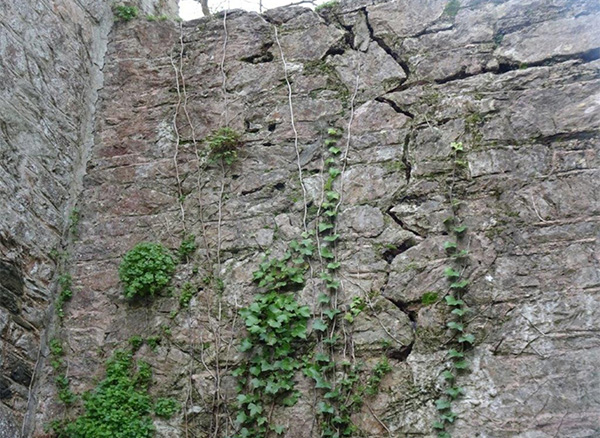
Movement
Movement affecting a property could be caused by several mechanisms and is commonly evidenced by visible cracking to the structure. Some small cracks are typical of a structure, such as those occurring at the abutment of an extension to the original structure for example (especially if the construction materials are different). Such small cracks can be made good by filling with a flexible material allowing it to expand and contract naturally without cracking. There are many mechanisms which could cause structural movement, such as:
- Subsidence/settlement: Associated with the settling/sinking of the structure, often the result of soil shrinkage or poor foundations.
- Heave: In contrast to subsidence or settlement, heave occurs where excess water becomes present in the soils beneath a property, causing it to lift up, or ‘heave’.
- Thermal movement: Cracking is commonly caused by typical expansion and contraction of construction materials. Limited movement of this nature is normal but should be monitored to ensure it does not become progressive.
- Deflection of floor decks: Movement of this manner is commonly identified in older properties where the timber joists and floorboards are undersized, built into solid walls (and thus prone to rotting) or where partition walls are built directly off the floor deck (not supported by partitions below). This can be evidenced by the dropping or displacement of doorframes and other joinery.
- Drains: Drainage media passing near or directly beneath a structure can be problematic in the event of failure. This could cause the ground beneath the structure to be washed away.
- Trees: Trees growing close to a structure can cause movement through disturbances caused by root growth.
- Corrosion of metals: The most common in this respect is cavity wall tie failure. Please see our section referring directly to this.
The above is not an exhaustive list and only outlines common issues in relation to structural movement. Where cracking is evident at a property a surveyor may be able to establish its cause during an inspection and determine whether it is a long term threat to the structure. However, if the surveyor decides that further specialist advice or a second opinion would be prudent, a structural engineer could be recommended. Similarly, if you identify cracks in your property which you are uncertain of or uncomfortable with then a structural engineer can assist. A structural engineer would proceed to recommend remedial works where necessary.
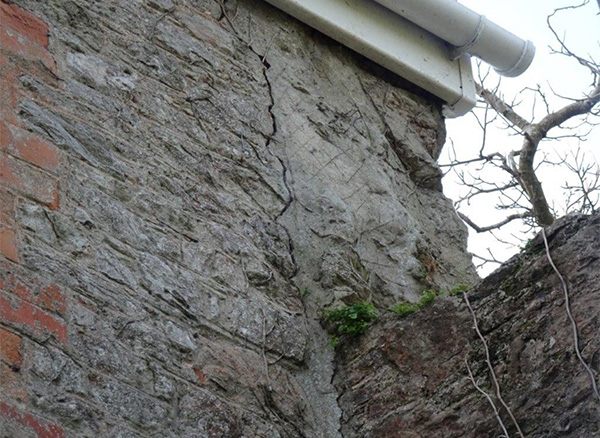
Movement

Movement
These photographs show a gap between the tenement and the main part of the house where there is a gap of about 1.5" or 40 mm. The gap is easily visible both internally and externally. It is in an area which used to be marshland and which was a flood plain (although flood defence schemes means there has been no flooding for over 50 years). The ground conditions are therefore very poor. Many of the tenements have been underpinned, and some re-built. Foundations have sometimes had to go down over 8 metres in order to be supported by firm ground.

Non escape window
As of April 2002 regulations have been introduced specifying that all replacement windows should have opening mechanisms permitting occupants to escape or be rescued in the event of a fire. It is a common limitation in properties, especially those with ageing window installations that windows are of the non-escape variety. As a result there are obvious health and safety implications. Although, there may be additional means of escape from a room, such as patio doors for example.
The two pictures adjacent show a complying escape window and a non-escape window.
If a window system does not comply with these regulations the matter should be assessed and resolved by an appropriately qualified person. Since 2002, regulations state window installations must be carried out with a building regulation approval, or by a FENSA registered contractor.

Pitch Fibre Drains
Pitch fibre is a material used in the construction of underground pipes primarily during the 1950’s and 1960’s. It is a relatively cheap and easily handled material lending itself to use in the forming of drainage pipework, however inherent defects in the construction material soon became apparent. Pitch fibre is prone to delamination of the internal surface, the degradation of which reduces the pipework’s strength so that failure and collapse (under normal conditions) can occur.
Pitch fibre is relatively straightforward to identify, it is jet black in colour and will have a fibrous appearance compared to other underground pipework materials such as clay or PVC.
The presence of pitch fibre can affect a property’s insurability, so that an insurance policy on normal terms may not cover failure of pitch fibre pipework. As a result, where pitch fibre is identified, its full replacement is always recommended.
Responsibility for the maintenance of underground drains should be confirmed by your legal adviser since the responsibility for shared drains passed to your local water company in October 2011.

Pot Block
A construction form often employed for external walls of domestic structures between 1930 and 1955. The construction form has poor insulation values and will be prone to penetrating damp and condensation issues. Cavity wall insulation cannot be introduced into walls of this construction type. The construction form is not universally acceptable to mainstream mortgage lenders.

Photo Voltaic Panels
Purchasers have been warned against making offers to buy properties fitted with free solar panels, over fears their mortgages will be turned down. Homeowners selling properties which buyers cannot get a mortgage for could end up being forced to pay tens of thousands of pounds to buy themselves out of the solar panels scheme. This issue has been triggered by the mounting problem of mortgage lenders refusing loans for homes where companies have fitted solar panels for free. They do so in return for long leases giving them ownership of the roof space above the property for typically 25 years.
Individual solar panels aren't particularly heavy but the total additional loading may be significant, especially on roofs with lightweight claddings and timbers. Building Regulation approval is required if the panels will add more than a third of the weight of the existing roof covering so a proper initial assessment is critical. Such installations should only be introduced after obtaining an engineer’s assessment of the roof structure.
The nature of the installation process means that a degree of damage to the roof covering is almost inevitable. Installing the panel fixings usually involves exposing the supporting structure beneath the existing roof covering. Avoiding any damage during this work is difficult, so completing effective repairs should be a standard part of the installation process. Installations are much more difficult with some coverings, such as slates, than others. Was any damage properly repaired? Is the roof still completely watertight? Checking these details is far beyond the scope of a mortgage valuation inspection so a detailed inspection will be necessary to answer these questions.

Rainwater Goods
Inadequate disposal of rainwater from a property can be the cause of problems such as damp, timber decay and structural movement. Therefore, it is essential that gutters, downpipes and the gulleys/drains to which they connect are regularly cleared, cleansed and in good condition. Gutter falls may depreciate over time encouraging gutters to clog (see photo), they should be checked periodically to ensure gutters lead to downpipes efficiently. It is common for gutter joints to fail and leak. The effectiveness of rainwater goods should be monitored during heavy rainfall confirm adequacy and identify potential defects.
It is not unusual for rainwater downpipes to discharge onto the ground. This should be avoided and an appropriate gulley/drain provided, leading to a suitable soakaway. Rainwater should not be disposed into foul drainage systems.
Hopper arrangements serving several downpipes (and occasionally waste kitchen/bathroom waste pipes – see our photos) are a common source of problem and should be avoided where possible. If absolutely essential connections should be made thoroughly without over burdening the primary downpipe.

Seagulls
Apart from stealing your ice cream or chips, seagulls can also pose a nuisance by nesting on roof slopes. As well as the seagulls being particularly noisy, the debris created by their nests can impede effective drainage of surface water from the roof slopes. Removal of the nest and regular cleansing is recommended. Beware as the seagulls may be aggressive, particularly around their young.

Shuttered mass concrete
This is concrete (sometimes with large stones incorporated) poured within shuttering to form the walls and footings. This was in regular use between 1900 and 1950 this being the time when poor aggregates were also frequently used. It is common for the material to have a Mundic problem and therefore it needs to be examined in the same way.
In many apparently stone built houses it is used for party walls, rear extensions, etc. It can be difficult to detect normally being rendered and plastered over. In particular it is difficult to differentiate from brick, thin stone or block walls. The thickness can be between 4" (100mm) and 18" (450mm) according to location.
Mass concrete is prone to damp problems and offers poor insulation, in exactly the same way as the solid block and stone walls referred to above. Mass concrete buildings are difficult to adapt and are not acceptable to some lenders.
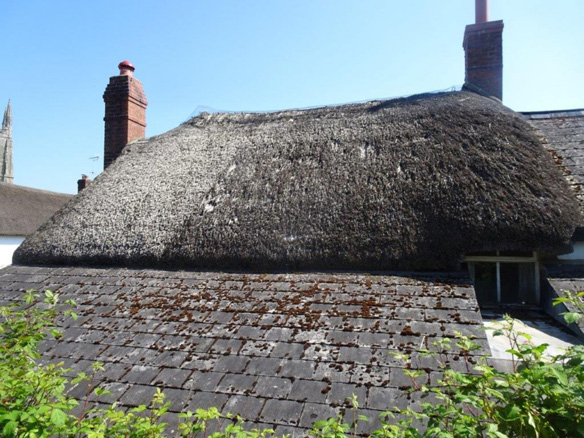
Thatch
There are a variety of types of thatch material (reeds and straws) and techniques all with a differing life expectancy. Straw thatch tends to have a shorter life than reed thatch and has traditionally been more common in the West Country but reed thatch is gradually being used more widely. Often the reed can now be sourced from eastern Europe although traditionally reed has been grown more locally particularly in parts of Somerset and Devon.
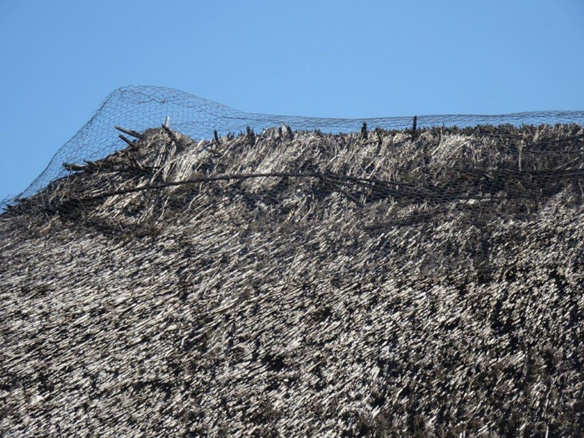
Thatched Roof
Position, roof pitch, climate and quality of work also affect the overall life. Regular maintenance by a competent thatcher is essential. Building insurance costs will be increased. The Thatching Advisory Service can assist in this and many other aspects. Recladding may necessitate new carcassing. Many thatched buildings are listed or in a conservation area and have to be re-thatched in the same type of material. Fire is a major risk (electrical and flue gases are the prime causes) but modern techniques can reduce the risk.
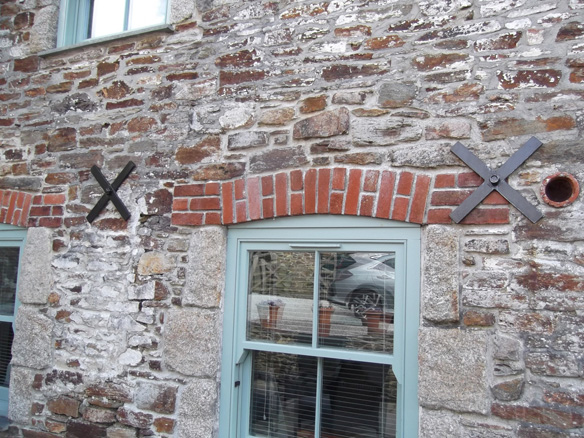
Tie Bars (Tie Rod)
In construction, tie bars are used to provide additional restraint to a structure which may be suffering from structural movement and instability. Tie bars can also be implemented to prevent roof spread, where the over burden of a roof structure on the load bearing walls pushes them apart.
Tie bars are normally formed of steel or iron, threaded through a structure from one wall to another (including partition walls where necessary, see photos) typically adjacent to ceilings, in floor voids or roof voids. Externally plates either round in shape, ‘X’ shaped or ‘S’ shaped in common with threaded bolts are used to tie the bars to the structure. Therefore, the presence of tie bars should be reasonably apparent (see photos).
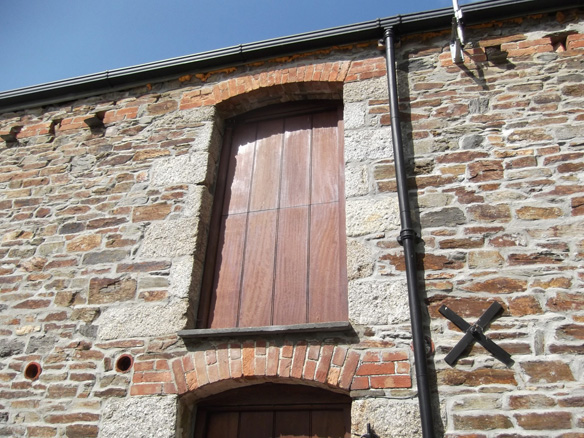
Tie Bars (Tie Rod)
In a similar fashion to buttresses, the presence of tie bars is a good indicator that structural movement has occurred at a property. A surveyor may recommend a report from a structural engineer if the property is still at risk. If a property includes a tie bar, or tie bars, this should be declared to your buildings insurance company.

Vermin
Vermin infestation is unfortunately a rather common occurrence, typically affecting the roof void of a property. Evidence usually constitutes vermin droppings or damage to materials within the roof void, insulation to pipework is a favourite of theirs but chattels may also be affected. DIY techniques, typically poison or traps, can be employed to control the infestation. However, if the problem persists a pest control expert could be consulted.
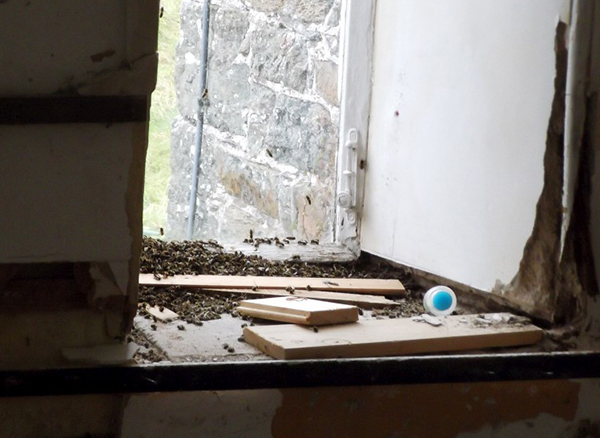
Wasps
Where wasps and bees nests are found at a property their location is typically in the roof space or eaves, or as our picture shows in abandoned areas of a property. They have a habit of finding points of entry under loose roof tiles, around flashing details at abutments/junctions or through any gaps on masonry at the eaves. This is obviously a nuisance and typically uncomfortable for the occupiers.
Appropriate precautions, such as full protective clothing, should be taken if you are to pursue DIY techniques in eradicating the nest. Recommended techniques include the use of chemical sprays or powders, but if you have any doubts or are uncomfortable in using such methods you should instruct a pest control expert.
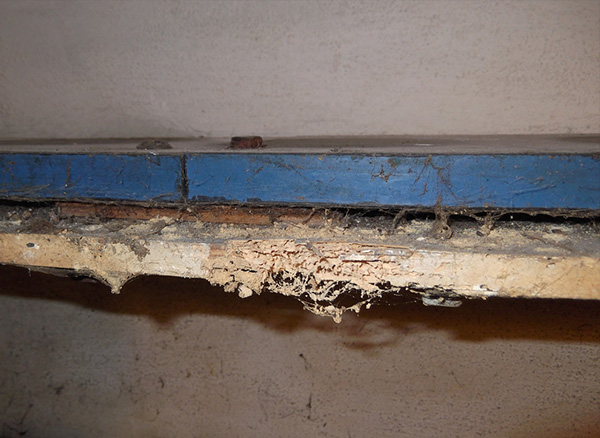
Woodboring insect infestation
There are several species of woodboring insects, they are well known for their destruction of property. Destruction occurs by the larva burrowing (feeding) for several years within timber of a suitable type and age. Most timbers used in dwellings locally are suitable. The flight holes are the only indication. These are formed at the end of the larva stage when the insect emerges. Insects have a short life during which they lay eggs which produce more larva and so on. Treatment is usually needed to prevent eventual failure. Given early treatment it is rare for insect infestation to cause failure of a timber. Woodworm, etc. will occur in concealed timbers such as floor joists and treatment needs to recognise this.
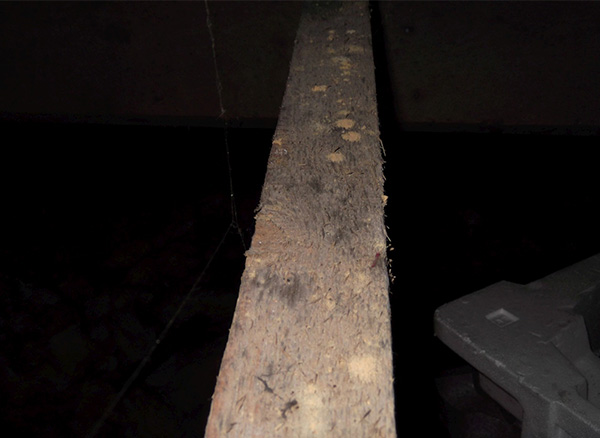
Woodboring insects
Insect infestation normally occurs eventually in all houses and is usually fairly easily treated by a specialist contractor. We would recommend that you engage a competent timber treatment specialist to inspect the property, opening up the structure where necessary to sufficiently investigate all deterioration caused by fungal decay and wood boring insects. They should be asked to provide an estimate of the cost of treatment and any necessary repairs. We recommend that you select a firm (preferably PCA approved) offering a worthwhile warranty that is preferably reinsured.